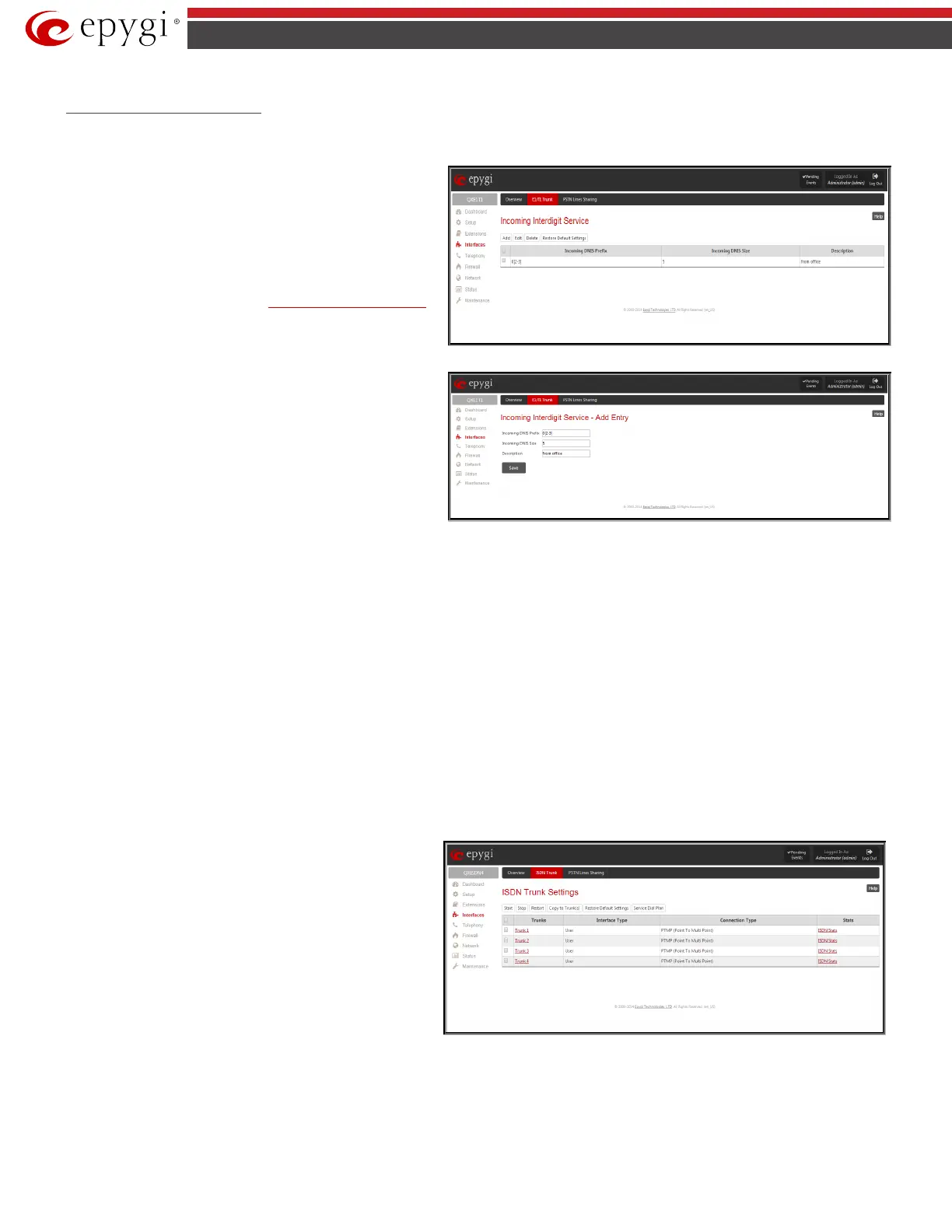QX5
QXFXO4/QXISDN4/QXE1T1/QXFXS24; (SW Version 6.0.x) 44
QXFXO4/QXISDN4/QXE1T1/QXFXS24 Manual II: Administrator’s Guide
Incoming Interdigit Service
Incoming Interdigit Service
is used to configure E1/T1 dial plan for the incoming calls from CO/PBX to the QX. This service allows you to speed up
the call establishment procedure by detecting the prefix. The calls will be speed up by the timeout defined in the
Incoming Digits Timeout
When the system detects incoming dialed number starting with any
of the prefixes listed in the
Incoming Interdigit Service
wait for the rest of the digits, as specified for the corresponding
prefix in the Incoming DNIS Size text field (see below). Once all
digits are received, the system will route the call to the destination.
The Incoming Interdigit Service page lists a table with existing
E1/T1 dial plan entries and allows you to manage them.
By default, the table on the Incoming Interdigit Service page lists
the locale specific (selected from the
System Configuration Wizard)
E1/T1 dial plan settings. For some countries, this table may however
be empty.
Fig.II- 52: Incoming Interdigit Service page
Add
functional button leads to the
Add Entry
page where a new
E1/T1 dial plan entry can be configured.
The Add Entry page consists of the following fields:
The Incoming DNIS Prefix text field requires the prefix of the
incoming dialed number. '[' , ']' , ',', '-', are used to define a range or
a quantity of prefixes. For example, 2[5-9] means that the prefix of
the dialed number may be 25, 26, 27, 28, or 29. 3[4,7,0] means that
the prefix of the dialed number may be 34, 37 or 30. Only one range
of prefixes can be defined in the Incoming DNIS Prefix text field.
Fig.II- 53: Incoming Interdigit Service – Add Entry page
The Incoming DNIS Size text field requires the total length of the dialed number, including the prefix digits. The number defined in this field should be
greater than the longest prefix defined in the Incoming DNIS Prefix text field, otherwise the error message will appear.
The Description text field requires an optional description for an E1/T1 dial plan entry.
The Restore Default Settings functional button is used to restore the locale specific E1/T1 dial plan entries
ISDN Settings
The Integrated Services Digital Network (ISDN) is distinguished by digital telephony and data-transport services offered by regional telephone carriers.
ISDN involves the digitization of the telephone network, which permits voice, data, text, graphics, music, video, and other source material to be
transmitted over existing telephone wires. The ISDN Basic Rate Interface (BRI) service offers two B channels (voice transfer) and one D channel (signaling
data transfer). The BRI B-channel service operates at 64 kbit/s and is meant to carry user data. The BRI D-channel service operates at 16 kbit/s and is
meant to carry control and signaling information, although it can support user data transmission under certain circumstances.
The ISDN service allows QXISDN4 gateway act as a user or as a network. If connected to a private PBX, the QXISDN4 should be configured in the network
mode. If an ISDN trunk from the CO (Central Office) is connected to the QXISDN4, it should be configured as a user. QXISDN4 supports the MSN (Multiple
Subscriber Number) service, i.e., it can be subscribed to multiple numbers from the CO, and two simultaneous calls can take place at a time.
The ISDN Trunk Settings page is used to configure the ISDN trunk and their signaling. There are 4 ISDN trunks available on the QXISDN4 gateway.
The Trunk Settings table lists the available ISDN trunks on the QXISDN4 and their settings (trunk name and interface types).
Start
Stop
functional links are used to start/shutdown the
selected ISDN trunk(s). When an ISDN trunk is in a shutdown
state, ISDN calls cannot be placed or received.
The Restart functional link is used to bring channel(s) to the initial
idle state on both sides. When applying one of these options, any
active traffic on the channel(s) will be terminated.
The Copy to Trunk(s) functional link displays a page used to
choose a trunk to which selected trunk’s settings should be copied
to.
Restore Default Settings
functional link restores the default
signaling settings of the selected ISDN trunk(s).
Fig.II- 54: ISDN Trunk Settings page
Clicking on the corresponding ISDN trunk will lead to the ISDN wizard where trunk’s ISDN signaling settings can be configured. The ISDN Wizard
consists of several pages.
The ISDN Wizard – ISDN Settings allows you to choose the interface type and the connection type of the selected trunk(s).
